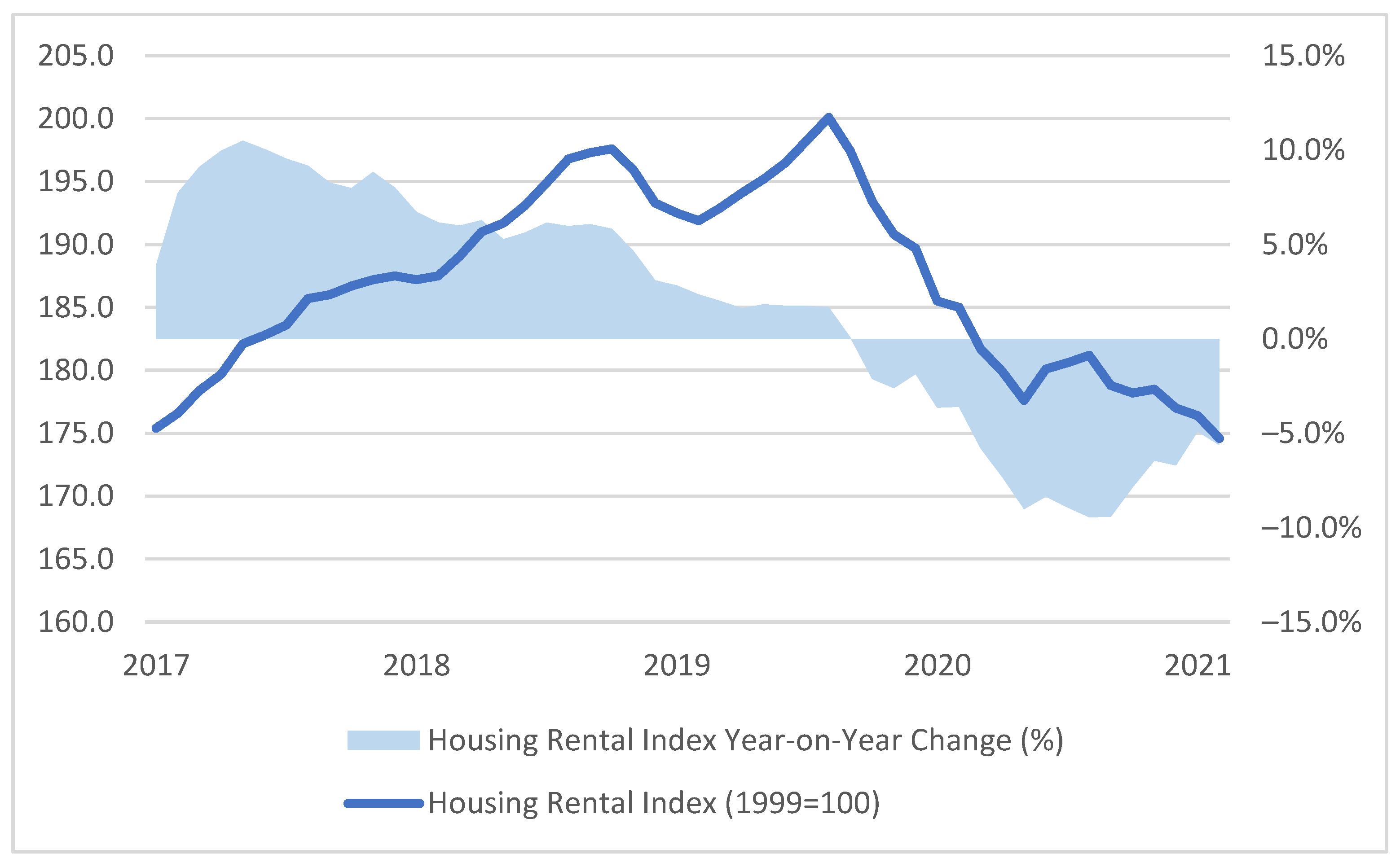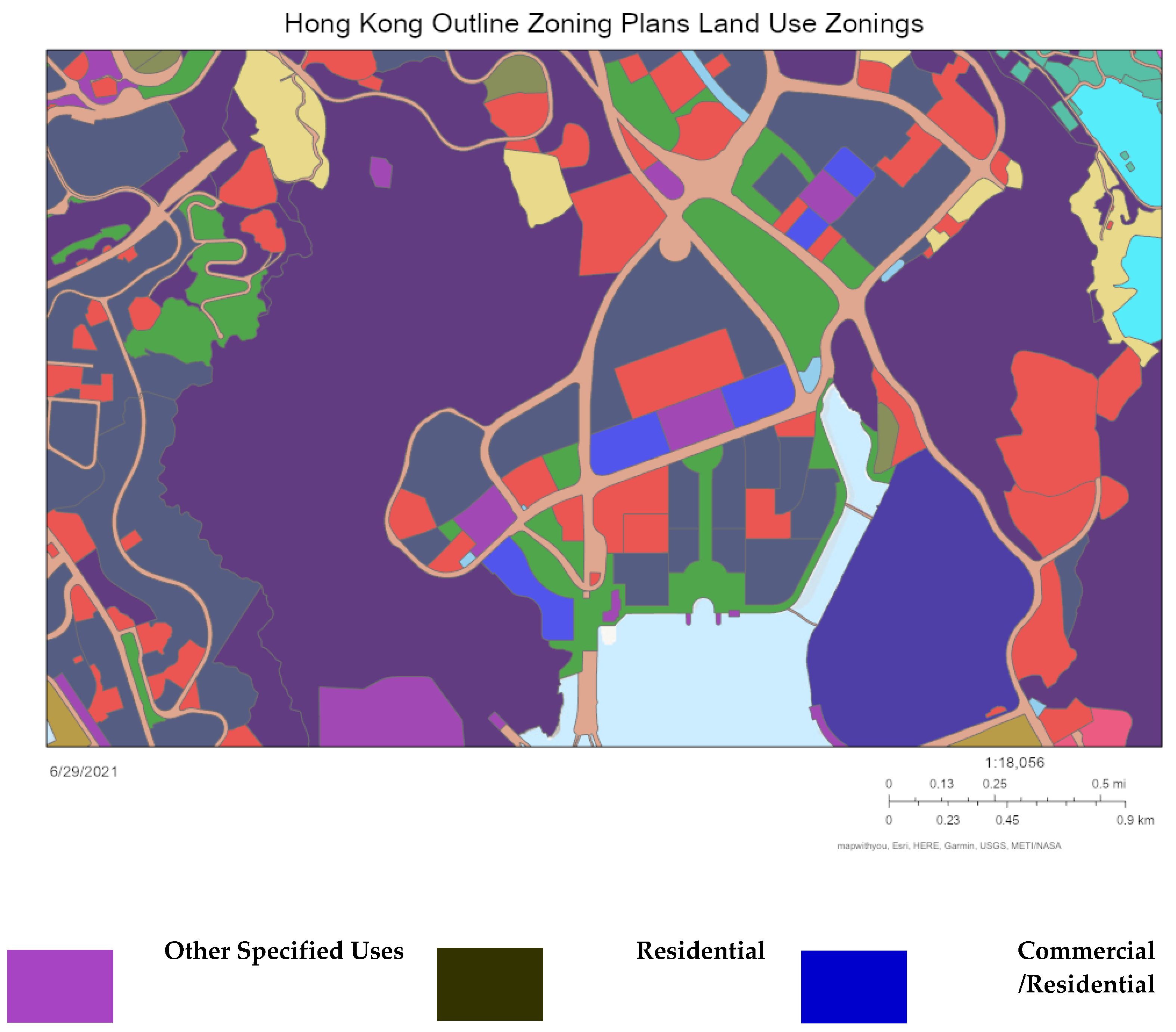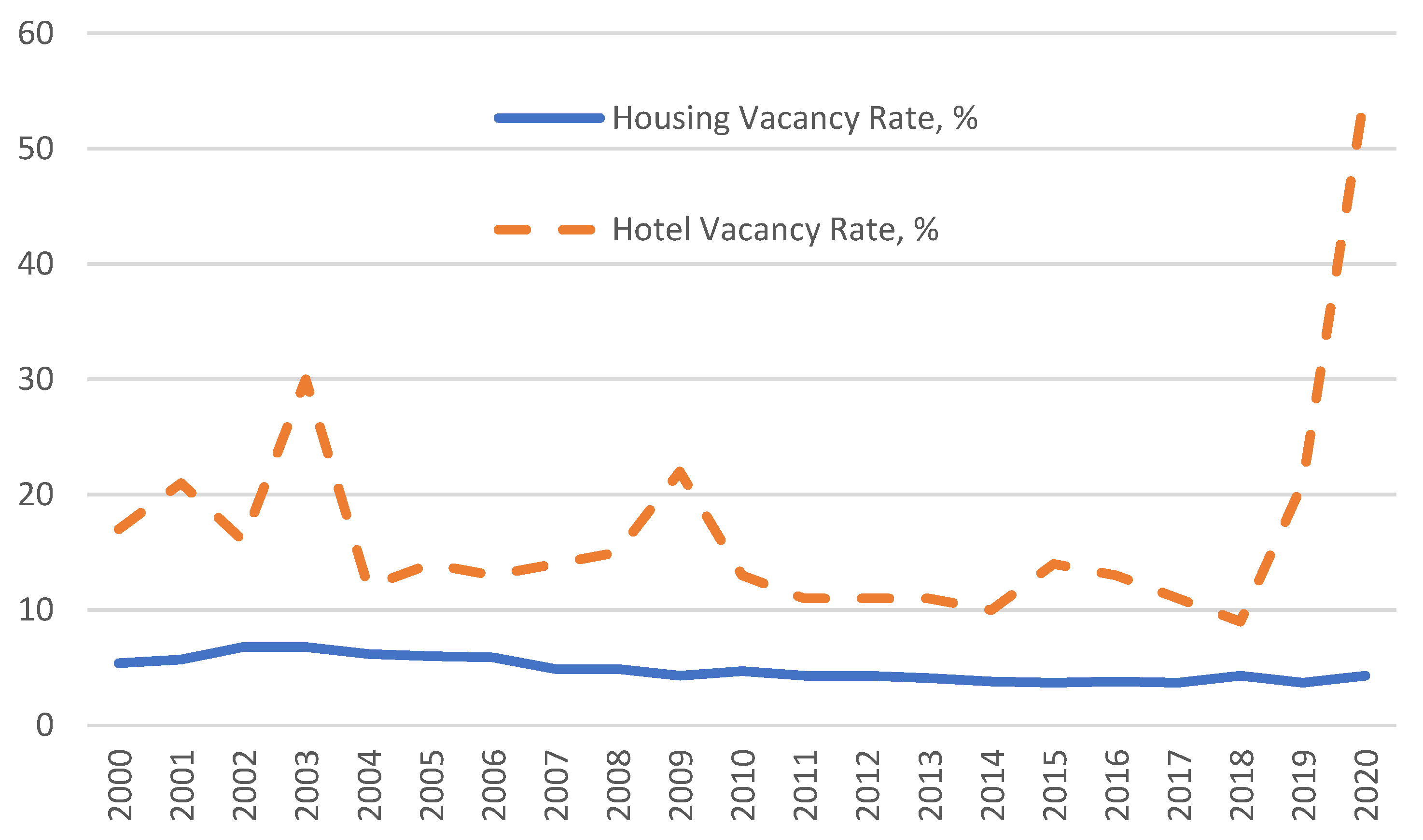Urban Zoning for Sustainable Tourism: A Continuum of Accommodation to Enhance City Resilience
Abstract
:1. Introduction
2. Literature Review
3. Materials and Methods
3.1. Switching Options Embedded in Performing Planning
3.2. A Case Study of Serviced Apartments in Hong Kong
3.3. Repeat-Sales Method
4. Results and Discussion
4.1. Results
4.2. Discussion
5. Conclusions
Author Contributions
Funding
Institutional Review Board Statement
Informed Consent Statement
Data Availability Statement
Conflicts of Interest
References
- Dolnicar, S. Peer-to-Peer Accommodation Networks—Pushing the Boundaries; Goodfellow Publishers Ltd.: Oxford, UK, 2018; Available online: https://library.oapen.org/bitstream/id/8c26ef66-8bbd-4aa2-ad44-e0e47d3bcc9e/640674.pdf (accessed on 18 June 2021).
- Koster, H.R.A.; van Ommeren, J.; Volkhausen, N. Short-term rentals and the housing market: Quasi-experimental evidence from Airbnb in Los Angeles. J. Urban Econ. 2021, 124, 103356. [Google Scholar] [CrossRef]
- Hong Kong Legislation. Cap. 349 Hotel and Guesthouse Accommodation Ordinance. 1991. Available online: https://www.elegislation.gov.hk/hk/cap349 (accessed on 10 January 2021).
- Becker, G. Crime and Punishment: An Economic Approach. J. Political Econ. 1968, 76, 169–217. Available online: https://www.jstor.org/stable/1830482 (accessed on 10 January 2021). [CrossRef] [Green Version]
- Polinsky, A.M.; Shavell, S. The Economic Theory of Public Enforcement of Law. J. Econ. Lit. 2000, 38, 45–76. Available online: https://www.jstor.org/stable/2565359 (accessed on 10 January 2021). [CrossRef] [Green Version]
- Nieuwland, S.; van Melik, R. Regulating Airbnb: How cities deal with perceived negative externalities of short-term rentals. Curr. Issues Tour. 2017, 23, 811–825. [Google Scholar] [CrossRef] [Green Version]
- Palombo, D. A Tale of Two Cities: The Regulatory Battle to Incorporate Short-Term Residential Rentals into Modern Law. Am. Univ. Bus. Law Rev. 2015, 4, 287. Available online: https://ssrn.com/abstract=3156798 (accessed on 10 January 2021).
- Schäfer, P.; Braun, N. Misuse through short-term rentals on the berlin housing market. Int. J. Hous. Mark. Anal. 2016, 9, 287–311. [Google Scholar] [CrossRef]
- Leshinsky, R.; Schatz, L. I Don’t Think My Landlord Will Find Out: Airbnb and the Challenges of Enforcement. Urban Policy Res. 2018, 36, 417–428. [Google Scholar] [CrossRef]
- Inside Airbnb. Detailed Listings Data for Hong Kong, Get the Data. Available online: http://insideairbnb.com/get-the-data.html (accessed on 10 January 2021).
- UNWTO. Travel Tomorrow. Available online: https://www.unwto.org/traveltomorrow (accessed on 10 January 2021).
- RVD. Private Domestic—Rental Indices by Class (Territory-Wide) Data Series; Rating and Valuation Department; HKSAR Government. 2021. Available online: https://www.rvd.gov.hk/mobile/en/property_market_statistics/index.html (accessed on 14 April 2021).
- Rivolin, U.J. Conforming and performing planning systems in Europe: An unbearable cohabitation. Plan. Pract. Res. 2008, 23, 167–186. [Google Scholar] [CrossRef] [Green Version]
- Cullingworth, B.; Nadin, V. Town and Country Planning in the UK; Routledge: Oxfordshire, UK, 2006. [Google Scholar]
- Boyer, C.M. Dreaming the Rational City: The Myth of American City Planning; MIT Press: Cambridge, MA, USA, 1986. [Google Scholar]
- Carmona, M.; Carmona, S.; Gallent, N. Delivering New Homes: Processes, Planners and Providers; Psychology Press: London, UK, 2003. [Google Scholar]
- Rosenburg, M. Zoning: Residential, Commercial, or Industrial? Geography 2009. Available online: http://geography.about.com/od/urbaneconomicgeography/a/zoning.htm (accessed on 10 January 2021).
- Stair, P.; Wooten, H.; Raimi, M. How to Create and Implement Healthy General Plans. 2008. Available online: https://www.changelabsolutions.org/sites/default/files/Healthy_General_Plans_Toolkit_Updated_20120517_0.pdf (accessed on 18 June 2021).
- Elliot, D. A Better Way to Zone: Ten Principles to Create More Liveable Cities; Island Press: Washington, DC, USA, 2008. [Google Scholar]
- Booth, P. Discretion in planning versus zoning. In British Planning: 50 Years of Urban and Regional Policy; Cullingworth, J., Ed.; Continuum International Publishing: London, UK, 1999; pp. 31–44. [Google Scholar]
- Hillier, J. Stretching Beyond the Horizon: A Multiplanar Theory of Spatial Planning and Governance; Aldershot: Ashgate, UK, 2007. [Google Scholar]
- Steele, W. Strategy-making for Sustainability: An Institutional Learning Approach to Transformative Planning Practice. Plan. Theory Pract. 2011, 12, 205–221. [Google Scholar] [CrossRef]
- Baker, D.C.; Sipe, N.G.; Gleeson, B.J. Performance-Based Planning: Perspectives from the United States, Australia, and New Zealand. J. Plan. Educ. Res. 2006, 25, 396–409. [Google Scholar] [CrossRef]
- Gielen, D.M.; Tasan-Kok, T. Flexibility in Planning and the Consequences for Public-value Capturing in UK, Spain and the Netherlands. Eur. Plan. Stud. 2010, 18, 1097–1131. [Google Scholar] [CrossRef] [Green Version]
- Steele, W.; Ruming, K.J. Flexibility versus certainty: Unsettling the land-use planning shibboleth in Australia. Plan. Pract. Res. 2012, 27, 155–176. [Google Scholar] [CrossRef]
- Gutiérrez, J.; García-Palomares, J.C.; Romanillos, G.; Salas-Olmedo, M.H. The eruption of Airbnb in tourist cities: Comparing spatial patterns of hotels and peer-to-peer accommodation in Barcelona. Tour. Manag. 2017, 62, 278–291. [Google Scholar] [CrossRef] [Green Version]
- Zervas, G.; Proserpio, D.; Byers, J.W. The rise of the sharing economy: Estimating the impact of Airbnb on the hotel industry. J. Mark. Res. 2017, 54, 687–705. [Google Scholar] [CrossRef] [Green Version]
- Dogru, T.; Hanks, L.; Mody, M.; Suess, C.; Sirakaya-Turk, E. The effects of Airbnb on hotel performance: Evidence from cities beyond the United States. Tour. Manag. 2020, 79, 104090. [Google Scholar] [CrossRef]
- Guttentag, D. Progress on Airbnb: A literature review. J. Hosp. Tour. Technol. 2019, 10, 814–844. [Google Scholar] [CrossRef]
- Doling, J.; Ronald, R. Bringing New Ideas to Housing Research. 2019. Available online: www.housing-critical.com (accessed on 14 April 2021).
- Lee, D. How Airbnb short-term rentals exacerbate Los Angeles’s affordable housing crisis: Analysis and policy recommendations. Harv. Law Policy Rev. 2016, 10, 229. Available online: https://harvardlpr.com/wp-content/uploads/sites/20/2016/02/10.1_10_Lee.pdf (accessed on 14 April 2021).
- Horn, K.; Merante, M. Is home-sharing driving up rents? Evidence from Airbnb in Boston. J. Hous. Econ. 2017, 38, 14–24. [Google Scholar] [CrossRef]
- Franco, S.F.; Santos, C.D.; Longo, R. The impact of Airbnb on residential property values and rents: Evidence from Portugal. FEUNL Working Paper Series wp630; Universidade Nova de Lisboa: Lisbon, Portugal, 2019; Available online: https://papers.ssrn.com/sol3/papers.cfm?abstract_id=3387341 (accessed on 14 April 2021).
- Barron KKung, E.; Proserpio, D. The Effect of Home-Sharing on House Prices and Rents: Evidence from Airbnb. 2020. Available online: https://ssrn.com/abstract=3006832 (accessed on 14 April 2021).
- Gurran, N.; Phibbs, P. When tourists move in: How should urban planners respond to Airbnb? J. Am. Plan. Assoc. 2017, 83, 80–92. [Google Scholar] [CrossRef] [Green Version]
- Lambea Llop, N. A policy approach to the impact of tourist dwellings in condominiums and neighbourhoods in Barcelona. Urban Res. Pract. 2017, 10, 120–129. [Google Scholar] [CrossRef]
- Wachsmuth, D.; Weisler, A. Airbnb and the rent gap: Gentrification through the sharing economy. Environ. Plan. A Econ. Space 2018, 50, 1147–1170. [Google Scholar] [CrossRef]
- DiNatale, S.; Lewis, R.; Parker, R. Short-term rentals in small cities in Oregon: Impacts and regulations. Land Use Policy 2018, 79, 407–423. [Google Scholar] [CrossRef]
- Gunter, U.; Önder, I.; Zekan, B. Modeling Airbnb demand to New York City while employing spatial panel data at the listing level. Tour. Manag. 2020, 77, 104000. Available online: https://www.sciencedirect.com/science/article/pii/S0261517719301980 (accessed on 18 June 2021). [CrossRef]
- Vinogradov, E.; Leick, B.; Kivedal, B.K. An agent-based modelling approach to housing market regulations and Airbnb-induced tourism. Tour. Manag. 2020, 77, 104004. Available online: https://www.sciencedirect.com/science/article/pii/S026151771930202X (accessed on 18 June 2021). [CrossRef]
- Airbnb New Study: Airbnb Community Generates $824 Million in Economic Activity in the UK. Available online: airbnb.co.nz/press/news/new-study-airbnb-community-generates-824-million-in-economic-activity-in-the-uk (accessed on 14 April 2021).
- Garate, S.; Pennington-Cross, A.; Zhao, W. The Effect of the Shared Economy on Crime: Evidence from Airbnb. Available online: https://www.aeaweb.org/conference/2021/preliminary/paper/TF3N368y (accessed on 3 January 2021).
- Cheung, K.S.; Yiu, C.Y. Understanding Touristification in the Sharing Economy: Airbnb and the Housing Market. 2021. Available online: https://www.aeaweb.org/conference/2021/preliminary/1709?q=eNqrVipOLS7OzM8LqSxIVbKqhnGVrJQMlWp1lBKLi_OTgRwlHaWS1KJcXAgrJbESJK9rDBLNzE2FiJZlppaDTCgqKFwwCpgagLQXJKanQowCXDC-7B6l (accessed on 14 April 2021).
- Regan, C.M.; Bryan, B.A.; Connor, J.D.; Meyer, W.S.; Ostendorf, B.; Zhu, Z.; Bao, C. Real options analysis for land use management: Methods, application, and implications for policy. J. Environ. Manag. 2015, 161, 144–152. [Google Scholar] [CrossRef] [PubMed]
- Yadipur, M.; Daglish, T.; Saglam, Y. Optimal Land Use Switching Policy. J. Agric. Resour. Econ. 2019, 58. [Google Scholar] [CrossRef]
- Shah, P.; Ando, W.A. Permanent and Temporary Policy Incentives for Conservation under Stochastic Returns from Competing Land Use. Am. J. Agric. Econ. 2016, 4, 1074–1094. [Google Scholar] [CrossRef]
- Hendricks Nathan, P.; Smith, A.; Sumner Daniel, A. Crop Supply Dynamics and the Illusion of Partial Adjustment. Am. J. Agric. Econ. 2014, 96, 1469–1491. Available online: https://www.jstor.org/stable/24476988 (accessed on 14 April 2021). [CrossRef] [Green Version]
- Song, F.; Zhao, J.; Swinton, S.M. Switching to Perennial Energy Crops Under Uncertainty and Costly Reversibility. Am. J. Agric. Econ. 2011, 93, 768–783. [Google Scholar] [CrossRef]
- Williams, J. Redevelopment of Real Assets. Real Estate Econ. 1997, 25, 387–407. [Google Scholar] [CrossRef]
- Capozza, D.R.; Sick, G.A. Valuing Long Term Leases: The Option to Redevelop. J. Real Estate Financ. Econ. 1991, 4, 209–223. [Google Scholar] [CrossRef] [Green Version]
- Capozza, D.R.; Li, Y. The Intensity and Timing of Investment: The Case of Land. Am. Econ. Rev. 1994, 84, 889–904. Available online: https://www.jstor.org/stable/2118036 (accessed on 14 April 2021).
- Yiu, C.Y.; Tam, C.S. Rational under-pricing in bidding strategy: A real options model. Constr. Manag. Econ. 2004, 24, 475–484. [Google Scholar] [CrossRef]
- Geltner, D.; Riddiough, T.; Stojanovich, S. Insights on the Effect of Land Use Choice: The Perpetual Option on the Best of Two Underlying Assets. J. Urban Econ. 1996, 39, 20–50. [Google Scholar] [CrossRef]
- Childs, P.D.; Riddiough, T.J.; Triantis, A.J. Mixed uses and the redevelopment option. Real Estate Econ. 1996, 24, 317–339. [Google Scholar] [CrossRef]
- Town Planning Board. Approved Tseung Kwan O Outline Zoning Plan No. S/TKO/28, Schedule of Uses. Town Planning Board, HKSAR Government. 2021. Available online: https://www2.ozp.tpb.gov.hk/gos/download.aspx?type=ozp&caseno=S/TKO/28&lang=0 (accessed on 14 April 2021).
- Hong Kong Town Planning Board. Town Planning Board Guidelines for Interim Planning Control on Service Apartment; TPB PG-NO. 2B. 2000. Available online: http://www.info.gov.hk/tpb/en/forms/Guidelines/pg2b_e.pdf (accessed on 14 April 2021).
- Bailey, M.J.; Muth, R.F.; Nourse, H.O. A regression model for real estate price index construction. J. Am. Stat. Assoc. 1963, 58, 933–942. [Google Scholar] [CrossRef]
- Hong Kong Tourism Board. Research & Statistics. 2021. Available online: https://partnernet.hktb.com/en/research_statistics/tourism_statistics_database/index.html (accessed on 14 April 2021).
- Shaw, D.; Lord, A. From Land-Use to ‘Spatial Planning’: Reflections on the Reform of the English Planning System. Town Plan. Rev. 2009, 80, 415–436. Available online: https://www.jstor.org/stable/40541501 (accessed on 14 April 2021). [CrossRef]
- Healey, P.; Hakee, K.; Motte, A.; Needham, B. Making Strategic Spatial Plans: Innovation in Europe; UCL Press: London, UK, 1997. [Google Scholar]
- Albrechts, L.; Healey, P.; Kunzmann, K. Strategic spatial planning and regional governance in Europe. J. Am. Plan. Assoc. 2003, 69, 113–129. [Google Scholar] [CrossRef]
- Albrechts, L. Shifts in strategic planning? Some evidence from Europe and Australia. Environ. Plan. A 2006, 38, 1149–1170. [Google Scholar] [CrossRef]







| yyyymm | RSADRI (201804 = 1) | yyyymm | RSADRI (201804 = 1) | yyyymm | RSADRI (201804 = 1) | yyyymm | RSADRI (201804 = 1) |
|---|---|---|---|---|---|---|---|
| 201901 | 1.0290 | 202001 | 0.9913 | 202101 | 0.9674 | ||
| 201902 | 1.0294 | 202002 | 0.9885 | 202102 | 0.9711 | ||
| 201903 | 1.0304 | 202003 | 0.9858 | ||||
| 201804 | 1.0000 | 201904 | 1.0352 | 202004 | 0.9845 | ||
| 201805 | 1.0020 | 201905 | 1.0216 | 202005 | 0.9855 | ||
| 201906 | 1.0196 | 202006 | 0.9859 | ||||
| 201807 | 0.9997 | 201907 | 1.0144 | ||||
| 201808 | 0.9996 | 201908 | 1.0101 | ||||
| 201809 | 1.0068 | 201909 | 1.0055 | ||||
| 201810 | 1.0139 | 201910 | 1.0015 | 202010 | 0.9562 | ||
| 201811 | 1.0204 | 201911 | 0.9979 | 202011 | 0.9600 | ||
| 201812 | 1.0264 | 201912 | 0.9951 | 202012 | 0.9637 |
Publisher’s Note: MDPI stays neutral with regard to jurisdictional claims in published maps and institutional affiliations. |
© 2021 by the authors. Licensee MDPI, Basel, Switzerland. This article is an open access article distributed under the terms and conditions of the Creative Commons Attribution (CC BY) license (https://creativecommons.org/licenses/by/4.0/).
Share and Cite
Yiu, C.-Y.; Cheung, K.-S. Urban Zoning for Sustainable Tourism: A Continuum of Accommodation to Enhance City Resilience. Sustainability 2021, 13, 7317. https://doi.org/10.3390/su13137317
Yiu C-Y, Cheung K-S. Urban Zoning for Sustainable Tourism: A Continuum of Accommodation to Enhance City Resilience. Sustainability. 2021; 13(13):7317. https://doi.org/10.3390/su13137317
Chicago/Turabian StyleYiu, Chung-Yim, and Ka-Shing Cheung. 2021. "Urban Zoning for Sustainable Tourism: A Continuum of Accommodation to Enhance City Resilience" Sustainability 13, no. 13: 7317. https://doi.org/10.3390/su13137317
APA StyleYiu, C.-Y., & Cheung, K.-S. (2021). Urban Zoning for Sustainable Tourism: A Continuum of Accommodation to Enhance City Resilience. Sustainability, 13(13), 7317. https://doi.org/10.3390/su13137317





_Cheung.jpeg)

